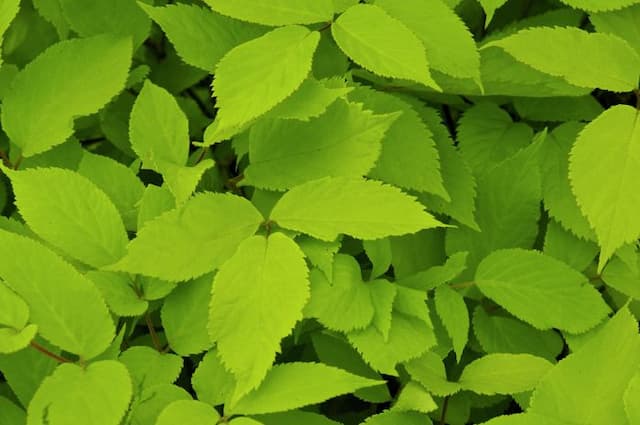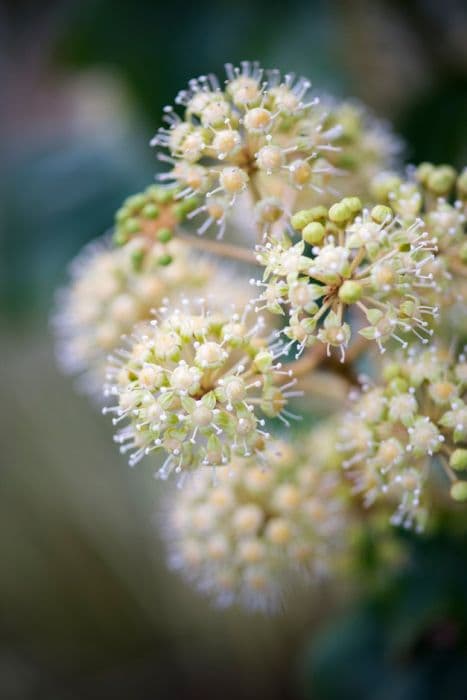Russian Ivy Hedera pastuchovii 'Ann Ala'

ABOUT
The plant known as 'Ann Ala' is a type of ivy with distinctive features. It boasts leaves that have a glossy texture and exhibit a rich green color. Each leaf is shaped with several pointed lobes that radiate out from a central point, giving them a star-like appearance. The edges of the leaves may have a slight wave or ruffle, which adds to the plant's visual interest. In terms of its growth habit, this ivy is known for clinging and climbing, thanks to its aerial roots that can adhere to various surfaces. It will typically produce long trailing vines that extend from the main plant, which can give it a lush and full appearance even without referring to the actual size. Throughout the seasons, the color of the leaves might deepen or vary slightly, but generally, they maintain their green vibrancy. In certain conditions, 'Ann Ala' may produce small flowers that are not particularly conspicuous, and these can mature into small, berry-like fruits. Overall, the plant presents a hardy and adaptable appearance, suitable for creating a verdant, evergreen coverage over the surfaces it climbs or trails upon, contributing to its popularity for both indoor and outdoor use.
About this plant
 Names
NamesFamily
Araliaceae
Synonyms
Ann Ala Ivy, Russian Ivy, Pastuchov's Ivy
Common names
Hedera pastuchovii 'Ann Ala'.
 Toxicity
ToxicityTo humans
The common name for Hedera pastuchovii 'Ann Ala' is English ivy. English ivy is considered to be toxic if ingested by humans. The plant contains compounds such as saponins and polyacetylene that can cause various adverse reactions. Symptoms of poisoning include gastrointestinal issues such as nausea, vomiting, diarrhea, and abdominal pain. In some cases, individuals might also experience dermatitis or skin irritation after handling the plant. It is important to seek medical attention if ingestion occurs, especially in young children, as the toxicity can be more severe in smaller bodies.
To pets
The common name for Hedera pastuchovii 'Ann Ala' is English ivy. English ivy is toxic to pets, including dogs and cats. Ingesting any part of the plant can lead to symptoms such as vomiting, diarrhea, excessive salivation, and abdominal pain. In severe cases, ingestion can result in more serious conditions like difficulty breathing or a coma, particularly if a significant amount of the plant is consumed. Pet owners should prevent their animals from accessing the plant and seek veterinary care immediately if they suspect that their pet has ingested any part of English ivy.
 Characteristics
CharacteristicsLife cycle
Perennials
Foliage type
Evergreen
Color of leaves
Green
Height
50 feet (15.24 meters)
Spread
50 feet (15.24 meters)
Plant type
Climber
Hardiness zones
5
Native area
Caucasus
Benefits
 General Benefits
General Benefits- Easy to grow: The Russian Ivy is known for being easy to care for, thriving in a variety of conditions.
- Ornamental value: With its attractive foliage, Russian Ivy is used as an ornamental plant to beautify gardens and homes.
- Versatile: It can be grown as a ground cover, as well as trained to climb structures, offering flexibility in landscaping.
- Shade tolerance: Russian Ivy is capable of growing in shady areas where other plants might struggle, making it useful for filling under-canopy spaces in gardens.
- Drought resistance: Once established, it's generally resilient to periods of low water, reducing the need for frequent irrigation.
- Soil stabilization: As a climbing and spreading plant, Russian Ivy can help prevent soil erosion on slopes and banks.
- Winter interest: Being evergreen, Russian Ivy provides greenery and interest even in the colder months when other plants have died back.
- Habitat support: It can offer shelter and sometimes food for various species of wildlife.
 Medical Properties
Medical PropertiesThis plant is not used for medical purposes.
 Air-purifying Qualities
Air-purifying QualitiesThis plant is not specifically known for air purifying qualities.
 Other Uses
Other Uses- Biodegradable mulch: Ann Ala ivy can be used as a natural, biodegradable mulch in gardens, protecting soil from erosion and helping retain moisture.
- Natural dye: The leaves of the Ann Ala ivy can be boiled to produce a yellow or dark brown dye for textiles or crafts.
- Privacy screens: When grown on trellises or fences, Ann Ala ivy can provide a dense screen for privacy or to block unsightly views.
- Topiary forms: The flexible stems of Ann Ala ivy can be trained over wire frames to create ornamental topiary shapes in gardens or containers.
- Erosion control for slopes: The plant's ability to spread and root easily makes it useful for stabilizing soil on slopes or in areas prone to erosion.
- Green roofs: This ivy can be planted on green roofs to provide insulation and reduce urban heat islands due to its dense foliage.
- Sound barrier: Thick growth of Ann Ala ivy on walls can help dampen noise pollution from busy streets or industrial areas.
- Support for beneficial insects: Dense foliage can offer habitat and nesting sites for beneficial insects, including some species of bees and butterflies.
- Creative arts and crafts: The leaves and vines can be used in the creation of natural wreaths, garlands, or other botanical art pieces.
- Camouflage for structures: Ann Ala ivy can be used to cover and blend unsightly structures like sheds, compost bins, or utility boxes into the garden landscape.
Interesting Facts
 Feng Shui
Feng ShuiThe plant Hedera helix, commonly known as English Ivy, can be used in Feng Shui to introduce wood element energy, enhance air quality, and promote balance and harmony in the home or office environment. It may be placed in the wealth corner, which is the southeast part of a space, to promote abundance and prosperity, or used as a climbing plant on a trellis or wall to encourage upward growth and aspirations.
 Zodiac Sign Compitability
Zodiac Sign CompitabilityThe Hedera helix is not used in astrology practice.
 Plant Symbolism
Plant Symbolism- Connection and Friendship: The Hedera pastuchovii 'Ann Ala', commonly known as the Russian Ivy, is often associated with connection and friendship due to its clinging nature which symbolizes the strong bond between friends.
- Eternal Life: Russian Ivy, like other ivy plants, is evergreen, symbolizing immortality and eternal life because of its ability to stay green year-round.
- Fidelity and Wedded Love: Due to its tendency to tightly wrap around structures, the Russian Ivy represents fidelity and wedded love, suggesting the clinging relationship between spouses.
- Protection: The dense foliage of the Russian Ivy is believed to symbolize protection and safety, providing shelter and concealing what it grows on.
- Determination and Persistence: With its vigorous climbing habit, the Russian Ivy is emblematic of determination and persistence, showcasing its ability to overcome obstacles and grow in challenging conditions.
 Water
WaterThe Russian Ivy, also known as Hedera pastuchovii 'Ann Ala', prefers consistently moist soil but is not tolerant of waterlogging. It's best to water this plant when the top inch of soil feels dry to the touch. Typically, indoor plants may require water every 7 to 10 days, but this can vary depending on environmental conditions such as temperature, humidity, and light exposure. A general guideline would be to provide approximately 16 to 24 ounces of water for an average potted plant, ensuring even distribution around the base of the plant without over-saturating the soil.
 Light
LightRussian Ivy thrives in medium to bright indirect light conditions. It is adaptable and can also grow in lower light areas, but the vibrancy of its foliage might diminish. A spot near a window that receives dappled sunlight or bright, indirect light for most of the day is ideal for this plant to flourish. Avoid direct sun, which can scorch the leaves.
 Temperature
TemperatureRussian Ivy prefers moderate to cool indoor temperatures, ideally between 50°F and 70°F. It can survive in temperatures as low as 30°F, but it's best to keep it away from freezing conditions. Conversely, prolonged exposure to temperatures above 80°F can stress the plant. To promote a healthy growth environment, maintain indoor temperatures within these ranges.
 Pruning
PruningRegular pruning can help maintain the shape of Russian Ivy and encourage fuller growth. It’s best to prune in the spring or after the growing season when the plant is not actively producing new leaves. Trim back leggy or overgrown vines to promote branching and remove any yellow or damaged leaves. Pruning every few months, or as needed to control growth, will keep your Russian Ivy looking its best.
 Cleaning
CleaningAs needed
 Soil
SoilThe best soil mix for the plant commonly known as the Caucasican Ivy should be well-draining with a mixture of potting soil, peat, and perlite at roughly equal parts. The soil pH should be slightly acidic to neutral, ranging between 6.0 to 7.5, to ensure optimal growth.
 Repotting
RepottingCaucasican Ivy should be repotted every two to three years to prevent it from becoming root-bound and to replenish its nutrients. Younger plants may require more frequent repotting as they are in a more active phase of growth.
 Humidity & Misting
Humidity & MistingCaucasican Ivy thrives best in moderate to high humidity levels, ideally between 40% to 50%. However, it is quite adaptable and can tolerate lower humidity levels commonly found in home environments.
 Suitable locations
Suitable locationsIndoor
Place in bright, indirect light; keep soil moist but not soggy.
Outdoor
Provide shaded area; water regularly to maintain moist soil.
Hardiness zone
5-11 USDA
 Life cycle
Life cycleAs a cultivar of Hedera pastuchovii, commonly known as Russian Ivy, 'Ann Ala' begins its life cycle with seed germination, given appropriate moisture and temperature conditions. The seedlings develop into juvenile plants, characterized by rapid vegetative growth and lobed leaves that form a dense ground cover or climb using aerial rootlets. The juvenile phase can last several years before the plant reaches maturity. Upon maturation, the plant undergoes a morphological change—its leaves become unlobed, and it becomes capable of flowering when environmental conditions permit, usually in late summer to autumn. The flowers are small, greenish-yellow, and arranged in umbels, which after pollination develop into small, blackberries dispersed by birds. With adequate care and suitable environmental conditions, Russian Ivy 'Ann Ala' is a perennial plant that can live for many years, continuing to grow vegetatively and reproducing through both seeds and vegetative propagation, such as stem cuttings.
 Propogation
PropogationPropogation time
Spring-Early Summer
The most popular method of propagating Hedera pastuchovii 'Ann Ala', commonly known as the Iranian Ivy, involves stem cuttings. This technique is typically most successful during the plant's active growth period in spring or early summer. To propagate by stem cuttings, a gardener would select a healthy piece of the vine, ideally 4 to 6 inches in length (about 10 to 15 centimeters), with several leaves. The bottom inch (2.54 centimeters) of the cutting should be stripped of leaves and dipped in rooting hormone to encourage root development. The prepared cutting is then planted in a well-draining soil mix in a pot, with the leafless part buried. The soil should be kept moist, and the pot placed in indirect light until roots have established, after which it can gradually acclimate to its normal growing conditions.









